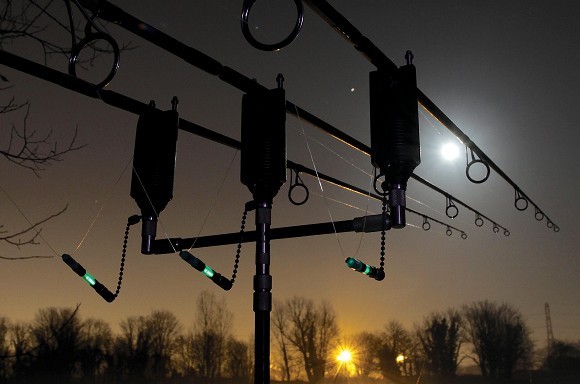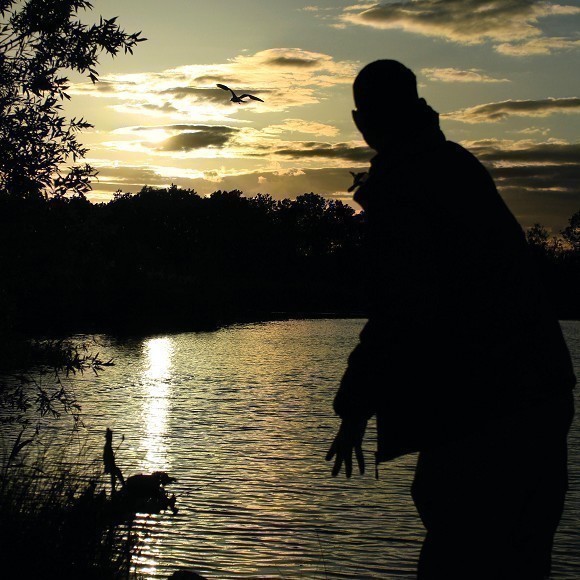
9 simple steps to catching more at night
How efficient is your fishing at night? Does your catch-rate drop with the sun? If the answer is yes or you’re simply new to night fishing then here’s Oli Davies with some pointers
Choosing a spot
Carp will often spend the daylight hours in one area, but then come darkness they will move off to another part of the lake to feed.
By identifying the habits of the carp in your lake, you can begin to predict which swims are best at which time of day and make your selection based on the time you will be on the bank.
If you have to be off early in the morning then you need to be looking for areas that will give the best chance of action during the hours of darkness. If you arrive in the dark it is worth spending a few minutes watching and listening for signs of fish.
Baiting
Many anglers fishing an overnight session put in far too much bait for the time that they are there. You are there to catch them not feed them! Baiting for a bite at a time can be a very effective tactic after dark, with the spot being topped up after each fish. If you are fishing close enough to bait using a catapult, in daylight find out how many baits it takes in the pouch at maximum power to reach the spot – too near and put less in, too far put more in – until you get the distance right. Then it is possible to re-bait reasonably accurately after each fish.
Alternatively, put in a couple of Spombs/spods of bait to top-up the spot. These can be clipped-up and lined-up with a far bank marker in the same way as you would with your fishing rods so again, accuracy should not suffer. To ensure that you have some free bait round the hookbait then there is no better method than a PVA bag. Keep a few tied ready for action.
Preparation and organisation
It really pays to be organised, especially after dark. Knowing where everything is and being able to lay hands on it easily will improve your efficiency and ultimately put more fish on the bank. Likewise, having rigs and leaders and PVA bags already tied and ready to go makes life much easier.
Keep your swim tidy, making note of any potential obstacles that you may trip over and don’t bivvy up too far from your rods. The closer you are the quicker you will be able to hit any takes. Ensure that your alarms are sufficiently loud to wake you quickly. It is irresponsible to sleep through a bite so if you are a heavy sleeper consider getting a remote that you can leave on the pillow.
However, preparation can be mental, as well as physical. It really pays to have a plan of action for when you do get a bite, especially if there are snags or weed to contend with. By having a plan and sticking to it in the heat of the moment you will land more fish, especially when you are half asleep having been woken by a take. I always lie there before I fall asleep running through my ‘plan’, in order to give me the best preparation possible. As it’s the last thing I am thinking of before I drop off it is fresh in my mind when I wake.
Equipment
You don’t have to take the kitchen sink, but ensure that you are equipped to fish comfortably. It you are cold, wet or hungry then you won’t fish well and you won’t enjoy yourself. First up is a shelter of some sort. Whether you choose a brolly or bivvy, this will be your base for the session. You want something that will keep you dry and out of the wind. If it is easy to erect and dismantle then that is even better.
During the summer months you may want to consider one with mosquito protection, as after dark they can be a real nightmare. A comfortable bedchair and sleeping bag are the next essentials, especially when the temperature begins to drop. Hot drinks and food are pretty much essential on an overnight session too, so be sure to take the brew kit and something hearty to eat. There is no need to suffer! It also pays to keep a spare change of clothes handy, in case you do get wet.
Catch pictures
So you’ve caught a carp after dark, and you want to take a trophy shot of it. Unfortunately, many anglers don’t get the trophy shot they want in the dark, but often this could easily be avoided by following a few simple guidelines. The first improvement that can be made is to find a background such as a hedge or some undergrowth. Put the mat right up against this so you have a background instead of just black in the shot. This will reflect some of the flash back and help brighten the picture.
Many cameras have a built-in flash, often positioned directly above the lens. This positioning leads to a couple of issues. First, it can ‘blow’ the side of the fish, causing loss of detail and ruining the picture. To avoid this try angling the fish very slightly so the flash isn’t reflected directly back at the lens. If the flash is too powerful or harsh and you can’t turn the power down, try diffusing it with a cigarette paper.
This central flash positioning can also produce the dreaded red-eye. This can be removed afterwards, but to avoid it and to really improve all your night photography, a dedicated flashgun is recommended. Even better is the use of multiple flashguns to illuminate the scene and spread the light evenly.
Alternatively, where sacking is allowed then fish can be retained until first light, but always ensure the welfare of the carp is the number one priority. Do not sack in shallow water and hot weather, or for long periods of time. Your sack should be properly secured and should have a marker attached to help locate it should it somehow come adrift. If
in doubt, do night shots and return the fish immediately.
Let there be light
A good headtorch is essential for any sort of fishing during the hours of darkness. What did we do before they were invented? Struggle, that’s what! Even the smallest tasks are much trickier when you can’t see what you are doing so be sure to invest in one.
There are many different models on the market, some more powerful than others. Some have a red LED, which can be very useful, as it doesn’t affect your night vision the way a white one does. Choose one that isn’t too bulky and is comfortable to wear, even in bed.
If you get a take while you are asleep you need to have it close to hand, or even better, wear it when you go to sleep so you are ready for action.
A larger, more powerful torch is not always essential but for some situations, for instance illuminating a spot that requires an accurate cast, it can be really useful so consider keeping one handy.
Be careful not to use a torch unnecessarily, particularly if you or neighboring anglers are fishing in the margins so be considerate; the disturbance will not be welcome. A head torch used prematurely can also cause a hooked carp near the net to spook, so be prepared for this and any sudden lunges when you switch it on during the battle.
Fishing, not camping
Remember, you are there to catch fish, so don’t be afraid to move swims should a better opportunity present itself, even if you have just set-up. You are better spending and hour in the right swim than 24 hours in the wrong one, and if this means upping sticks in the middle of the night because the fish are showing elsewhere then so be it. Remember, effort equals reward!
Evening sessions
You don’t have to fish the whole night or sleep on the bank to catch carp. Short evening sessions can be particularly productive, with many venues coming alive after dark. Particularly good for short sessions are rivers and canals, especially where the water is clear and the fish spooky.
As the light fails, the carp will move out of their safe areas in search of food, and a trap in the right area can produce a quick bite. Try targeting obvious features and holding areas such as snags, and fish for a bite at a time. Often, action will come quickly so a stealthy approach will pay dividends. Try not to shine too much light on the water and keep your footsteps light.
Go with a mate
The best night sessions are often social sessions, and teamwork can be very important in terms of both success and safety on the bank. If you can go with a friend, those times where you could do with an extra pair of hands become less fraught and you will have backup should something go wrong. You will also have someone to take your pictures when you catch that whacker!








